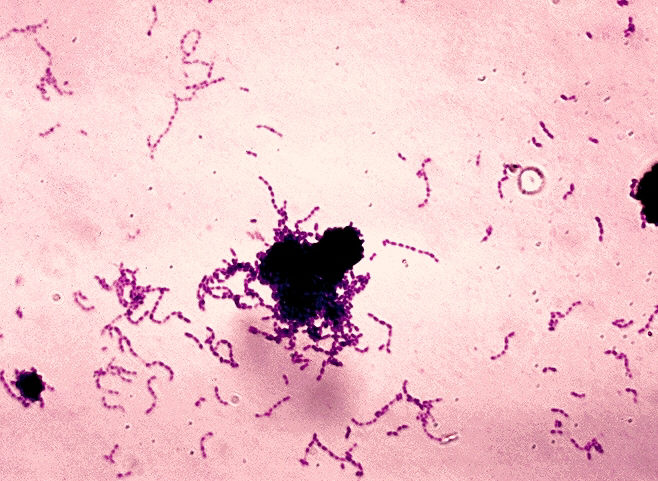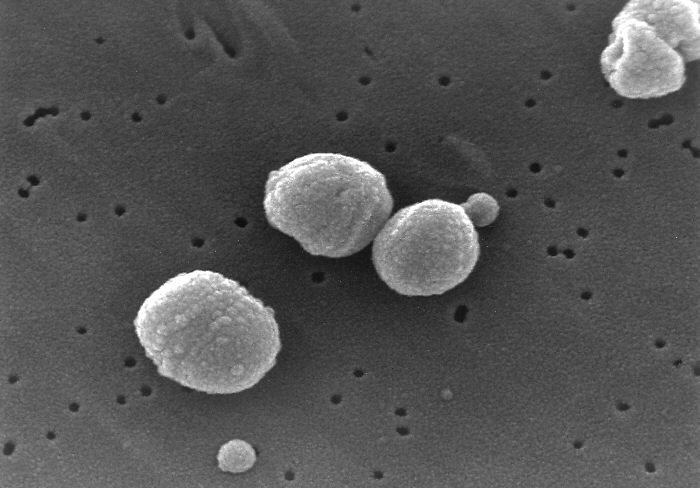Streptococcus is a genus of coccus (spherical) Gram-positive bacteria belonging to the phylum Firmicutes and the Lactobacillales (lactic acid bacteria) order. Cellular division occurs along a single axis in these bacteria, and thus they grow in chains or pairs, hence the nameâ€"from Greek στÏεπτός streptos, meaning easily bent or twisted, like a chain (twisted chain).
Contrast this with staphylococci, which divide along multiple axes and generate grape-like clusters of cells. Most streptococci are oxidase- and catalase-negative, and many are facultative anaerobes.
In 1984, many organisms formerly considered Streptococcus were separated out into the genera Enterococcus and Lactococcus. Currently, over 50 species are recognised in this genus.
Pathogenesis and classification

In addition to streptococcal pharyngitis (strep throat), certain Streptococcus species are responsible for many cases of pink eye, meningitis, bacterial pneumonia, endocarditis, erysipelas, and necrotizing fasciitis (the 'flesh-eating' bacterial infections). However, many streptococcal species are not pathogenic, and form part of the commensal human microbiome of the mouth, skin, intestine, and upper respiratory tract. Furthermore, streptococci are a necessary ingredient in producing Emmentaler ("Swiss") cheese.
Species of Streptococcus are classified based on their hemolytic properties. Alpha-hemolytic species cause oxidization of iron in hemoglobin molecules within red blood cells, giving it a greenish color on blood agar. Beta-hemolytic species cause complete rupture of red blood cells. On blood agar, this appears as wide areas clear of blood cells surrounding bacterial colonies. Gamma-hemolytic species cause no hemolysis.
Beta-hemolytic streptococci are further characterised by Lancefield serotyping, which describes specific carbohydrates present on the bacterial cell wall. The 20 described serotypes are named Lancefield groups A to V (excluding I and J).
In the medical setting, the most important groups are the alpha-hemolytic streptococci S. pneumoniae and Streptococcus viridans group, and the beta-hemolytic streptococci of Lancefield groups A and B (also known as “group A strep†and “group B strepâ€).
Alpha-hemolytic
Pneumococci
- S. pneumoniae (sometimes called pneumococcus), is a leading cause of bacterial pneumonia and occasional etiology of otitis media, sinusitis, meningitis, and peritonitis. Inflammation is thought to be the major cause of how pneumococci cause disease, hence the tendency of diagnoses associated with them to involve inflammation.
The viridans group: alpha-hemolytic
- The viridans streptococci are a large group of commensal bacteria, that are either α-hemolytic, producing a green coloration on blood agar plates (hence the name "viridans", from Latin vÄrÄdis, green), or nonhemolytic. They possess no Lancefield antigens.
Table: Medically relevant streptococci
Beta-hemolytic
Group A
S. pyogenes, also known as group A Streptococcus (GAS), is the causative agent in a wide range of group A streptococcal infections. These infections may be noninvasive or invasive. The noninvasive infections tend to be more common and less severe. The most common of these infections include streptococcal pharyngitis (strep throat) and impetigo. Scarlet fever is also a noninvasive infection, but has not been as common in recent years.
The invasive infections caused by group A β-hemolytic streptococci tend to be more severe and less common. This occurs when the bacterium is able to infect areas where it is not usually found, such as the blood and the organs. The diseases that may be caused include streptococcal toxic shock syndrome, necrotizing fasciitis, pneumonia, and bacteremia.
Additional complications may be caused by GAS, namely acute rheumatic fever and acute glomerulonephritis. Rheumatic fever, a disease that affects the joints, kidneys, and heart valves, is a consequence of untreated strep A infection caused not by the bacterium itself. Rheumatic fever is caused by the antibodies created by the immune system to fight off the infection cross-reacting with other proteins in the body. This "cross-reaction" causes the body to essentially attack itself and leads to the damage above. Globally, GAS has been estimated to cause more than 500,000 deaths every year, making it one of the world's leading pathogens. Group A Streptococcus infection is generally diagnosed with a rapid strep test or by culture.
Group B
S. agalactiae, or group B Streptococcus, GBS, causes pneumonia and meningitis in neonates and the elderly, with occasional systemic bacteremia. They can also colonize the intestines and the female reproductive tract, increasing the risk for premature rupture of membranes during pregnancy, and transmission of the organism to the infant. The American College of Obstetricians and Gynecologists, American Academy of Pediatrics, and the Centers for Disease Control recommend all pregnant women between 35 and 37 weeks gestation to be tested for GBS. Women who test positive should be given prophylactic antibiotics during labor, which will usually prevent transmission to the infant.
The United Kingdom has chosen to adopt a risk factor-based protocol, rather than the culture-based protocol followed in the US. Current guidelines state that if one or more of the following risk factors are present, then women should be treated with intrapartum antibiotics:
- Preterm labour (<37 weeks) - Prolonged rupture of membranes (>18 hours) - Intrapartum fever (>38C) - Prior GBS affected infant - GBS bacteriuria during this pregnancy
This protocol results in treatment of 15â€"20% of pregnant women and prevention of 65â€"70% of cases of early onset GBS sepsis.
Group C
This group includes S. equi, which causes strangles in horses, and S. zooepidemicusâ€"S. equi is a clonal descendent or biovar of the ancestral S. zooepidemicusâ€"which causes infections in several species of mammals, including cattle and horses. S. dysgalactiae is also a member of group C, β-haemolytic streptococci that can cause pharyngitis and other pyogenic infections similar to group A streptococci.
Group D (enterococci)
Many former group D streptococci have been reclassified and placed in the genus Enterococcus (including E. faecalis, E. faecium, E. durans, and E. avium). For example, Streptococcus faecalis is now Enterococcus faecalis.
The remaining nonenterococcal group D strains include Streptococcus bovis and Streptococcus equinus.
Nonhemolytic streptococci rarely cause illness. However, weakly hemolytic group D beta-hemolytic streptococci and Listeria monocytogenes (which is actually a Gram-positive bacillus) should not be confused with nonhemolytic streptococci.
Group F streptococci
Group F streptococci were first described in 1934 by Long and Bliss amongst the "minute haemolytic streptococci". They are also known as Streptococcus anginosus (according to the Lancefield classification system) or as members of the S. milleri group (according to the European system).
Group G streptococci
These streptococci are usually, but not exclusively, beta-hemolytic. S. canis is an example of a GGS which is typically found on animals, but can cause infection in humans.
Group H streptococci
Group H streptococci cause infections in medium-sized canines. Group H streptococci rarely cause illness unless a human has direct contact with the mouth of a canine. One of the most common ways this can be spread is human-to-canine, mouth-to-mouth contact. However, the canine may lick the human's hand and infection can be spread, as well.
Molecular taxonomy and phylogenetics

Streptococci have been divided into six groups on the basis of their 16S rDNA sequences: S. anginosus, S.bovis, S. mitis, S. mutans, S. pyogenes and S. salivarius. The 16S groups have been confirmed by whole genome sequencing (see figure). The important pathogens S. pneumoniae and S. pyogenes belong to the S. mitis and S. pyogenes groups, respectively, while the causative agent of dental caries,Streptococcus mutans, is basal to the Streptococcus group.
Genomics

The genomes of hundreds of species have been sequenced. Most Streptococcus genomes are 1.8 to 2.3 Mb in size and encode 1,700 to 2,300 proteins. Some important genomes are listed in the table. The four species shown in the table (S. pyogenes, S. agalactiae, S. pneumoniae, and S. mutans) have an average pairwise protein sequence identity of about 70%.
Treatment

